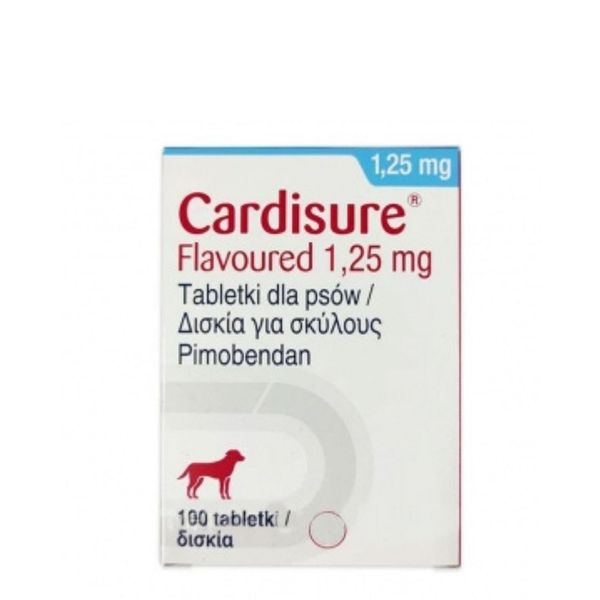|
Quantity
|
Out of stock
|
||
|
|
|||
Cardishur 2.5 mg, 10 tab
Description
Light brown round tablets with a cruciform groove on one side that divides the tablet into four equal parts and smooth on the other side.
Composition
1 tablet (weight 450.0 mg) contains the active substance:
pimobendan - 2.5 mg.
Excipients: microcrystalline cellulose, sodium croscarmellose, magnesium stearate, natural meat flavor OHLY.
Pharmacological properties
ATCvet classification code: QC01CE90 Non-glycoside cardiotonic veterinary drugs. Phosphodiesterase inhibitors. Pimobendan.
Pharmacodynamic properties
Pimobendan is a benzimidazole-pyridazinone derivative, a non-sympathomimetic, non-glycoside inotropic substance with powerful vasodilatory properties. It exerts a myocardial stimulating effect through a dual mechanism of action: it increases the calcium sensitivity of cardiac myofilaments and inhibits phosphodiesterase (type III). Pimbendan exerts a vasodilatory effect by inhibiting phosphodiesterase III activity.
When pimobendan is used in combination with furosemide for valvular insufficiency, it has been shown to improve the quality of life and prolong life expectancy in treated dogs.
In a limited number of cases, when used in combination with furosemide, enalapril and digoxin for symptomatic dilated cardiomyopathy, the drug has been shown to improve the quality of life and prolong life expectancy in dogs.
Pharmacokinetic properties
Absorption
After oral administration, the absolute bioavailability of the active substance is 60-63%. Since bioavailability is significantly reduced when pimobendan is administered with food or shortly after feeding, it is recommended that the drug be administered to animals approximately 1 hour before feeding.
Distribution
The volume of distribution is 2.6 L/kg, indicating that pimobendan is readily distributed into tissues. The average plasma protein binding is 93%.
Metabolism
The compound is oxidatively demethylated to the major active metabolite (UD-CG 212). Further metabolic pathways are phase II conjugates of UD-CG-212, essentially glucuronides and sulfates.
Excretion
The plasma half-life of pimobendan is 0.4 ± 0.1 hours. The major active metabolite is eliminated during the plasma half-life of 2.0 ± 0.3 hours. Virtually the entire dose is excreted in the faeces.
Application
For the treatment of dogs with congestive heart failure due to dilated cardiomyopathy or valvular insufficiency (mitral and/or tricuspid valve regurgitation).
Dosage
Do not exceed the recommended dose!
Before treatment, it is necessary to accurately determine the animal's body weight to ensure the correct dosage.
The tablets should be administered orally in a dose range of 0.2 to 0.6 mg pimobendan per 1 kg of body weight, divided into two doses per day.
The recommended daily dosage is 0.5 mg pimobendan per 1 kg of body weight. The dose should be divided into two doses of 1 tablet (2.5 mg pimobendan) per 10 kg of body weight - in the morning and approximately 12 hours later. The maintenance dose should be individually adjusted by the responsible veterinarian, taking into account the severity of the disease.
The drug can be combined with a diuretic, such as furosemide.
To divide the tablet into quarters, place the tablet on a flat surface with the score line facing up, hold one half of the tablet and press the middle of the tablet with your thumb.
Each dose should be given approximately one hour before feeding.
Contraindications
Do not use in hypertrophic cardiomyopathies or clinical conditions where increasing cardiac output is not possible for functional or anatomical reasons (e.g., aortic stenosis).
Since pimobendan is primarily metabolized in the liver, the drug should not be used in dogs with severe hepatic impairment.
Warning
Adverse reactions
Rarely, a mild positive chronotropic effect and nausea may be observed. However, these effects are dose-related and can be avoided by reducing the dose.
Transient diarrhea, anorexia, or lethargy have been observed rarely.
Rarely, an increase in mitral valve insufficiency has been observed with chronic pimobendan treatment in dogs with mitral valve disease.
Very rarely, signs of an effect on primary hemostasis (petechiae on the mucous membranes, subcutaneous hemorrhages) were observed during treatment, although it has not been clearly established that pimobendan is the cause of these symptoms. These signs disappear after discontinuation of treatment.
The frequency of adverse reactions is determined using the following model:
very common (more than 1 in 10 animals exhibiting adverse reactions during one treatment);
common (more than 1, but less than 10 per 100 animals);
uncommon (more than 1, but less than 10 per 1,000 animals);
rare (more than 1, but less than 10 per 10,000 animals);
very rare (less than one animal per 10,000 animals).
yh).
Precautions for use in animals
Flavored preparation. To avoid accidental ingestion, tablets should be kept out of reach of dogs.
A laboratory study on rat tissues demonstrated that, depending on the dose, pimobendan increases the release of insulin (at the expense of glucose) from pancreatic ß-cells. If the drug is given to dogs with diabetes mellitus, blood glucose levels should be carefully monitored.
For use of the drug for the treatment of dilated cardiomyopathy at the preclinical stage (asymptomatic course with an increase in the end-systolic and end-diastolic diameter of the left ventricle), it is necessary to conduct a diagnosis by a comprehensive cardiac examination (including echocardiography and, possibly, Holter monitoring).
For use in the treatment of preclinical myxomatous mitral valve disease (stage B2, according to ACVIM consensus: asymptomatic with mitral murmur > 3/6 and cardiomegaly due to myxomatous mitral valve disease), diagnosis should be made by a comprehensive physical and cardiac examination, which should include echocardiography or radiography, if necessary.
Monitoring of cardiac function and morphology is recommended in animals receiving pimobendan.
The drug has not been studied in cases of asymptomatic dilated cardiomyopathy (DCM) in Dobermans with atrial fibrillation or sustained ventricular tachycardia.
The drug has not been studied in cases of asymptomatic myxomatous mitral valve disease in dogs with significant supraventricular and/or ventricular tachyarrhythmia.
The drug should be administered to the animal on an empty stomach or one hour before feeding, since absorption of the drug decreases with food.
The safety of the drug in pregnant and lactating animals has not been assessed. It is recommended to use the drug only in accordance with the benefit / risk assessment of the responsible veterinary physician.
Dosage form
PVC blisters covered with aluminum foil, 10 tablets each, in a cardboard box. Each box contains 2, 5, 10 or 25 blisters.
Aluminum blisters of 5 tablets in a cardboard box. Each box contains 4, 10, 20 or 50 blisters.
Storage
Store at a temperature of 5 to 30 °C in the manufacturer's packaging.
Parts of a divided tablet should be stored in a blister for 3 days.
Shelf life - 2.5 years.
The shelf life of parts of divided tablets after the first opening of the blister is 3 days.
For use in veterinary medicine!































